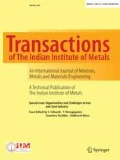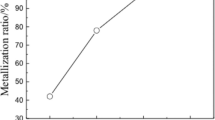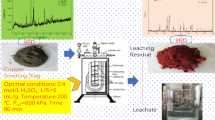Abstract
Substantial quantities of openly dumped slag contribute to the absence of recovery and utilization of valuable metals as well as potential environmental pollution to water and soil. Owing to the excessively high arsenic content present in iron extracted from copper smelting slag, we propose a new arsenic removal process in this paper. The results indicate that arsenic sulfides in copper smelting slag can be significantly removed at 1100 °C in an N2 atmosphere, leading to a 0.15% residual arsenic content. Furthermore, undecomposed arsenate in the slag can be reduced in an N2–CO atmosphere. During a coal-based direct reduction process, under optimal conditions, the removal efficiency of arsenic is relatively low. Subsequently, under optimal conditions, the arsenic content drops significantly from 0.18 to 0.080%. This new removal process engenders lower arsenic content in iron extracted from slag than the standards of pig iron and direct reduced iron in steelmaking.











Similar content being viewed by others
References
Zhang J, Qi Y H, and Yan D L, J Iron Steel Res Int 22 (2015) 396.
Wang Y, Nonferrous Mines 32 (2003) 19.
Li L, Hu J H, and Wang H, Chin J Process Eng 11 (2011) 65.
Bipra G, Jana R K, and Prem C, Conserv Recycl 39 (2003) 299.
Shen H, Forssberg E, Waste Manag 23 (2003) 933.
Yang T, Hu J H, and Wang H, Chin J Process Eng 11 (2011) 77.
Huang Z L, Luo F, and Li M, Conserv Util Min Resour 10 (2009) 54.
Liu G, Zhu R, and Wang C A, China Nonferrous Metall 02 (2009) 71.
Guo Z Q, Improving Separation of Cu Fe from Copper Slag by Modifying Melted Copper Slag, Central South University, Chang Sha (2014).
Yang H F, Jing L L, and Dang C G, Chin J Nonferrous Metal 21 (2011) 1165.
Wan X Y, Qi Y H, Gao J J, J Iron Steel Res 28 (2016) 22.
Lv Q, Huang H H, Liu X J, Iron Steel Van Titan 36 (2015) 83.
Wan X Y, Zhao K, and Qi Y H, Min Metall Eng 37 (2017) 73.
Wan X Y, Qi Y H, and Gao J J, Nonferrous Metals Eng 04 (2017) 32.
Liu L C, Res Iron Steel 02 (1977) 01.
Funding
Item Sponsored by National Science Foundation of China (51404075); Natural science foundation of Hebei Province (E2019209160) and Natural science foundation of Hebei Province (E2018209284).
Author information
Authors and Affiliations
Corresponding author
Additional information
Publisher's Note
Springer Nature remains neutral with regard to jurisdictional claims in published maps and institutional affiliations.
Rights and permissions
About this article
Cite this article
Wan, Xy., Hong, Lk., Qi, Yh. et al. Removal of Arsenic During Iron Extraction from Waste Copper Slag. Trans Indian Inst Met 73, 2683–2691 (2020). https://doi.org/10.1007/s12666-020-02056-x
Received:
Accepted:
Published:
Issue Date:
DOI: https://doi.org/10.1007/s12666-020-02056-x




